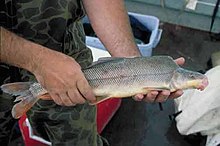| Razorback sucker | |
|---|---|

| |
| Scientific classification | |
| Domain: | Eukaryota |
| Kingdom: | Animalia |
| Phylum: | Chordata |
| Class: | Actinopterygii |
| Order: | Cypriniformes |
| Family: | Catostomidae |
| Genus: | Xyrauchen C. H. Eigenmann & Kirsch, 1889 |
| Species: | X. texanus
|
| Binomial name | |
| Xyrauchen texanus (C. C. Abbott, 1860)
| |
The razorback sucker (Xyrauchen texanus) is a suckerfish found in rivers and lakes in the southwestern United States and formerly northwestern Mexico. It can grow to 91 cm (3 ft) in length and is recognisable by the keel between its head and dorsal fin. It used to inhabit much of the Colorado River Basin but commercial fishing, river damming, and habitat loss have caused great declines in populations. It is now restricted to the Colorado River upstream of the Grand Canyon and to four reservoirs, Lake Mead, Lake Mohave, Lake Havasu, and Lake Powell.
It usually moves from deep water to suitable spawning grounds to breed, and research into its habits and breeding locations is ongoing. It has been a federally protected fish since 1991 and is rated as "Critically Endangered" by the International Union for Conservation of Nature, and Critically Imperiled by NatureServe. There are some signs of recovery, with fish being observed in the lower Grand Canyon in 2012 and 2013.[3]
- ^ NatureServe (2020) [errata version of 2013 assessment]. "Xyrauchen texanus". IUCN Red List of Threatened Species. 2013: e.T23162A174781799. doi:10.2305/IUCN.UK.2013-1.RLTS.T23162A174781799.en. Retrieved 12 November 2021.
- ^ "Xyrauchen texanus". NatureServe Explorer. 7.1.
- ^ "Tagged Razorback Suckers Released in Grand Canyon" (Press release). Grand Canyon, Arizona: National Park Service. February 24, 2015 [First published April 14, 2014]. Retrieved December 19, 2022.

